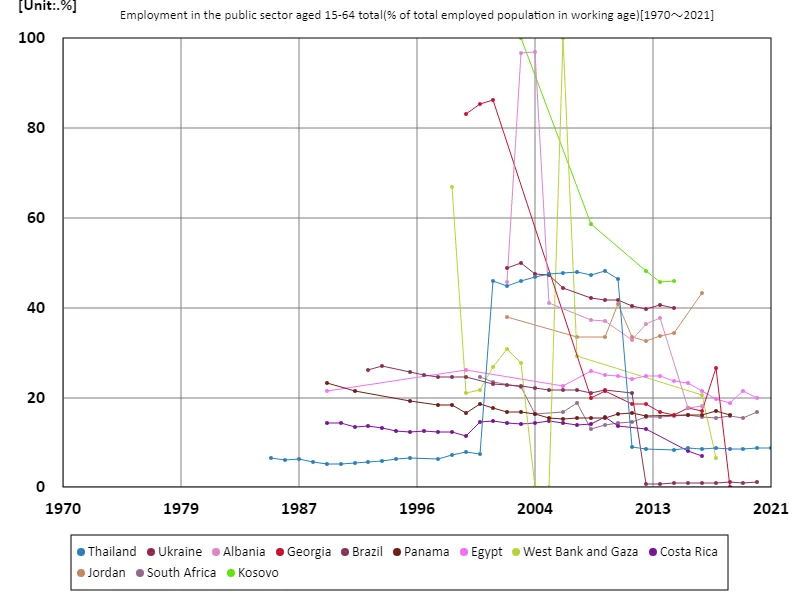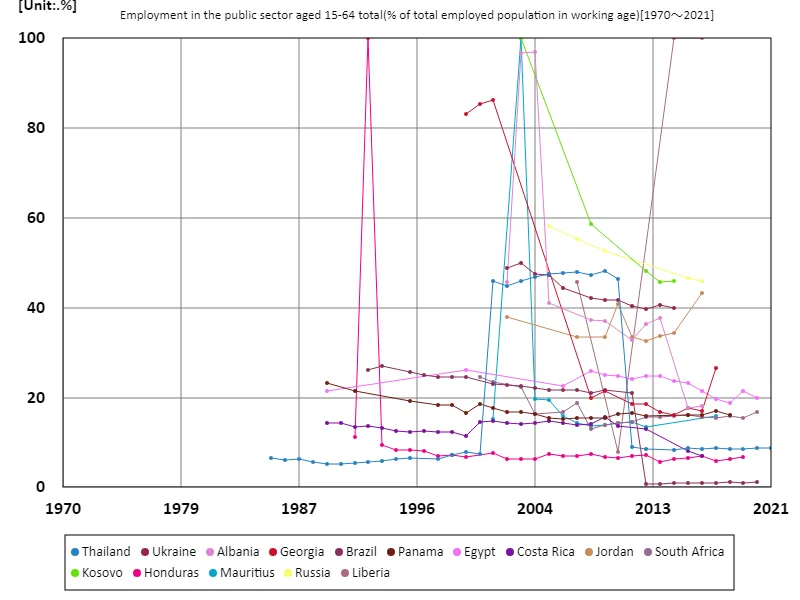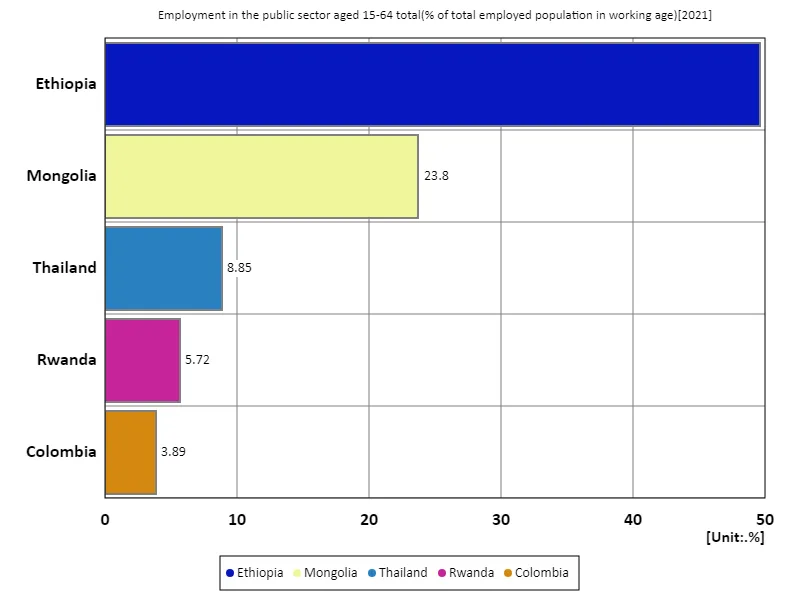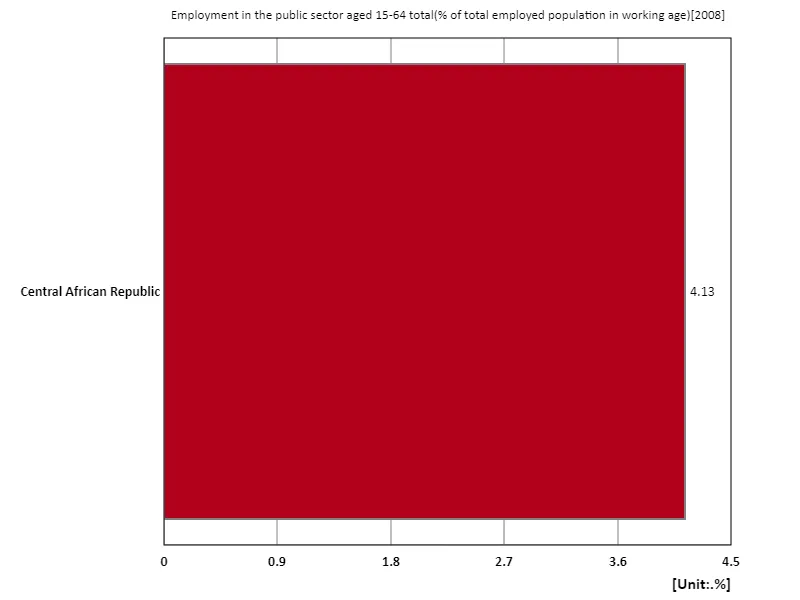- Abstract
- Employment rate in the public sector for all 15-64 year olds (percentage of working-age population)
- Employment rate in the public sector (percentage of working-age population) for all 15-64 year olds (worldwide)
- Employment rate in the public sector for all 15-64 year olds (percentage of working age working population) (Worldwide, latest year)
- Overall, public sector employment rate for 15-64 year olds (percentage of working age working population) (region, latest year)
- Reference
Abstract
In terms of public sector employment rate, Thailand recorded the highest value in 2021 at 8.85%. Thailand’s public sector plays a key role in the country’s economic and social policies, and its high employment rate is linked to the extensive provision of public services. Over the past few decades, Thailand has experienced rapid economic growth while also focusing on expanding its public sector. Meanwhile, in developed countries, public sector employment rates are generally lower and tend to be led by the private sector. For example, while public sector employment is relatively stable in OECD countries, it is typically below 5%. In contrast, in emerging and developing countries, there is a need to improve social services and strengthen administration, so employment rates in the public sector tend to be relatively high. Thailand’s high public sector employment rate is part of a policy aimed at economic growth and social stability.
Employment rate in the public sector for all 15-64 year olds (percentage of working-age population)
Looking at public sector employment rates based on data from 1985 to 2021, Kosovo’s evolution is particularly interesting. In 2003, Kosovo recorded a 100% public sector employment rate for the working age population aged 15-64 years, an extreme figure that reflects the socio-economic situation in Kosovo. The year 2003 was a time when Kosovo was under international protection and highly economically dependent. Therefore, it is likely that the public sector accounted for all employment. However, Kosovo’s public sector employment rate has since fallen significantly, to 45.9% in 2021. This decline can be attributed to the expansion of the private sector of the economy, international economic assistance, and structural reforms. In countries like Kosovo, the role of the public sector often changes due to the influence of international aid and monitoring agencies. As the private sector grows, public sector employment tends to fall as the economy becomes more self-reliant. Compared to other countries, public sector employment rates remain stable in most developed countries, typically ranging from 5% to 15%. In contrast, cases like Kosovo present a unique situation where changes in economic and social policies can have a significant impact on public sector employment.


The maximum is 100%[2003] of Kosovo, and the current value is about 45.9%
Employment rate in the public sector (percentage of working-age population) for all 15-64 year olds (worldwide)
The fact that Honduras’ public sector employment rate reached 100% in 1992 was a highly unusual case, and it is possible that this was due to economic turmoil and political upheaval. The year was 1992 and Honduras was recovering from the effects of civil war and the government was the major employer. This high public sector employment rate is likely due to the fact that the provision of public services was necessary to maintain social stability. However, in subsequent decades, Honduras’ public sector employment rate has fallen significantly, to 6.82% in 2021. This change is seen as the result of more efficient government, an expanding private sector, and international economic assistance. As Honduras implemented economic reforms and sought to develop the private sector and attract foreign capital, public sector employment rates fell. This trend is also seen in many other countries. Generally, as the economy stabilizes and the private sector develops, public sector employment rates tend to decline. The example of Honduras can also be understood as part of changes in economic structure and policy developments that are reducing the role of the public sector.


The maximum is 100%[1992] of Honduras, and the current value is about 6.82%
Employment rate in the public sector for all 15-64 year olds (percentage of working age working population) (Worldwide, latest year)
According to 2021 data, Ethiopia’s public sector employment rate is 49.7%, the highest overall. This figure shows that Ethiopia remains highly dependent on the public sector. Ethiopia’s economic base is underdeveloped, meaning that the government is the main employer and responsible for providing public services. This high public sector employment rate is a common feature across countries at different stages of economic development and where the role of government is large. Meanwhile, the overall average public sector employment rate is 18.4%, indicating that the private sector plays a leading role in many countries. In developed countries, public sector employment rates are typically below 10%, reflecting the maturity of the economy and the strength of the private sector. In contrast, in many developing countries and countries with economies in transition, public sector employment rates are relatively high and the role of government is important. Countries like Ethiopia have a high public sector share because public sector employment is essential for social stability and the provision of basic services. In contrast, as the economy grows and the private sector develops, public sector employment tends to decline gradually. As such, we can see that differences in economic development stages and policies have a significant impact on public sector employment rates.


The maximum is 49.7% of Ethiopia, the average is 18.4%, and the total is 91.9%
Overall, public sector employment rate for 15-64 year olds (percentage of working age working population) (region, latest year)
Data from 2008 show that the overall public sector employment rate averages 4.13%, with the Central African Republic having the highest rate. The data shows that the public sector’s share of the working-age population is roughly equal across the board. The public sector employment rate of 4.13% is relatively low, indicating that the public sector plays a smaller role in the labour market globally. The Central African Republic has the highest figure due to its unique socio-economic situation. In many developing countries, the public sector is relatively small and public sector employment tends to be low, particularly in countries like the Central African Republic, due to limited government resources and support. This may explain why public sector employment remains a small proportion of employment compared to more socio-economically stable countries. In general, public sector employment rates in developed countries are relatively high, often ranging from 5% to 20%, but overall they are characterized by a strong influence of the private sector. In developing countries, the role of government may be relatively large, but public sector employment overall is often low. This shows that public sector employment rates depend heavily on the stage of economic development and the state’s resource allocation.


The maximum is 4.13% of Central African Republic, the average is 4.13%, and the total is 4.13%



Comments